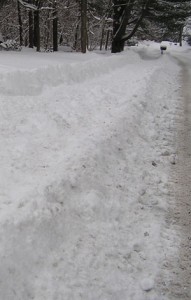Tue 5 Apr 2011
Near Miss Yesterday, Catastrophe Tomorrow?
Posted by Christian Donner under Traffic and SafetyComments Off on Near Miss Yesterday, Catastrophe Tomorrow?
Yesterday, we had a near miss in Medfield, when an elderly woman floored her Jaguar after dropping a letter into a mailbox at the post office. Various reports of the incident quoted the daughter of the driver who was in the passenger seat as saying “We mailed our letter in the post, stepped on the gas and we rocketed.”
The car crossed the adjacent parking lot at 50 North Street and then continued past the building over a steep drop where a stone wall caused the vehicle to overturn (see red arrow in the picture). Unimaginable grief could have been inflicted on this community, had the children been playing outside at the time. This patio is usually bustling with kids.
It takes about 5 seconds for an accelerating car to travel the 200 feet from the mailbox to the patio. The driver had 5 seconds to realize that she had stepped on the gas pedal instead of the break, and to make a correction by putting the foot back onto the brake. 5 seconds are an eternity, but it was not enough. Nobody with a 5 second reaction time should be driving on public roadways, regardless of age.
Let’s make sure that this near miss is not ignored.





